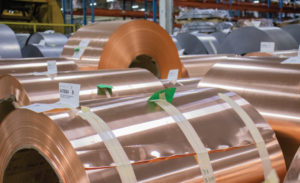From Art to Performance: The Many Applications of Distinct Copper Products
From Art to Performance: The Many Applications of Distinct Copper Products
Blog Article
Exactly How Copper Products Add To Sustainable Practices in Different Fields
Copper items are progressively recognized for their substantial payments to lasting techniques across several fields, driven by their intrinsic residential properties such as resilience, effectiveness, and recyclability. In sustainable energy systems, for instance, copper enhances the functionality of solar and wind modern technologies, while its application in building decreases waste with long life. The material's antimicrobial qualities supply promising benefits in medical care settings. As markets seek to adopt even more sustainable practices, the function of copper could show pivotal in attaining ecological objectives. What implications might this have for future technologies in sustainability?
Copper in Renewable Resource
Copper plays an important role in the improvement of sustainable energy modern technologies, acting as a crucial conductor in different applications. Its extraordinary electrical conductivity and resistance to deterioration make it an excellent material for electrical circuitry, which is vital in photovoltaic panels, wind generators, and energy storage systems. In solar photovoltaic systems, copper is used in the interconnections and wiring, making it possible for efficient power conversion from sunlight to power.
In wind power, copper is essential to the generators and transformers that convert kinetic power right into electric energy, ensuring optimum efficiency and integrity. Additionally, the need for electric vehicles (EVs) is boosting, with copper being a key component in batteries, motors, and charging facilities. The transition to EVs substantially boosts the demand for copper, as these lorries generally utilize four times much more copper than standard internal burning engine lorries.
As the globe looks for to reduce environment modification and change to lasting power resources, copper's duty becomes significantly important. The product not only boosts the effectiveness and durability of renewable resource systems however also supports the more comprehensive goal of minimizing greenhouse gas exhausts and advertising a lasting future.
Eco-Friendly Building Materials
Over the last few years, there has actually been a notable change in the direction of the fostering of eco-friendly building and construction products in response to growing environmental issues. This modification is motivated by the demand for lasting choices that minimize ecological footprints while maintaining architectural stability and visual appeal.
Copper, understood for its toughness and recyclability, has actually emerged as a principal in this sector. It can be made use of in roofing, pipes, and electric systems, adding to energy performance and reducing waste. Copper's durability means less substitutes in time, more enhancing its sustainability account.
Furthermore, materials such as bamboo, reclaimed wood, and reused steel are gaining popularity. These options not only supply lowered environmental impact yet additionally promote resource preservation. As building codes increasingly highlight sustainability, engineers and builders are integrating these materials into their tasks, promoting development in design.
The enhancing fostering of environmentally friendly building materials reflects a broader dedication to sustainability in the constructed setting. By focusing on these materials, the building market can significantly decrease its carbon footprint, straighten with governing requirements, and support a healthier ecosystem for future generations. This trend notes a crucial step towards a more lasting future in building.
Copper's Function in Medical care
Current researches have highlighted the considerable function of copper in health care setups, especially due to its antimicrobial residential properties. Copper surface areas have been revealed to minimize the visibility of virus, consisting of germs and viruses, by as much as 99.9% within a short duration. This exceptional effectiveness makes copper an important material for high-touch surfaces in hospitals, such as doorknobs, bed rails, and IV posts, consequently adding to boosted infection control actions.
In enhancement to its direct antimicrobial impacts, copper likewise plays a function in the wider context of healthcare facility sustainability (Copper Products). By incorporating copper into medical devices and furnishings, healthcare facilities can reduce the occurrence of healthcare-associated infections (HAIs), which not only enhances client end results but additionally lowers the prices related to extensive health center remains and additional therapies
Furthermore, copper's resilience and recyclability line up with sustainable methods, permitting accountable check it out source administration. As medical care systems significantly focus on both client safety and security and ecological stewardship, the integration of copper products is coming to be much more common. This dual advantage underscores copper's crucial contribution to a healthier, much safer, and much more sustainable health care setting.
Sustainability in Transportation

Moreover, copper's sturdiness and rust resistance add to the durability of transportation framework (Copper Products). In rail systems, as an example, copper elements boost the integrity and effectiveness of signaling and power systems, vital for lowering hold-ups and power intake. Furthermore, copper's role in renewable resource systems, such as solar and wind, supports sustainable transport remedies by offering clean energy for electrical transportation choices
Investments in copper innovation not just foster sustainability yet likewise promote financial development and job development in green markets. As industries make every effort to meet rigid ecological laws, the application of copper items in transport arises as a crucial my sources approach in achieving sustainability objectives and advertising a cleaner, much more efficient future.
Copper and Circular Economy
As the world progressively accepts sustainability, the function of copper in the circular economy ends up being ever before extra significant. Copper's innate homes-- such as its conductivity, resilience, and recyclability-- position it as a crucial product in a resource-efficient economic situation. The circular economy intends to lessen waste and take full advantage of source use via recycling and reusing materials, and copper master this respect.
The steel can be recycled forever without loss of high quality, making it an ideal candidate for sustainable practices throughout different markets, consisting of building, electronic devices, and renewable resource. By recovering and reprocessing copper from end-of-life products, industries can dramatically decrease the demand for virgin materials, thereby decreasing ecological effects linked with mining and handling.
In addition, the integration of copper right into round economic climate structures not just saves sources yet likewise fosters innovation. Services that focus on copper recycling add to an extra visit site lasting supply chain, improving their competition while aligning with governing demands and customer choices for eco responsible products.
Conclusion
To conclude, copper products considerably contribute to lasting methods throughout several fields. Their essential role in enhancing renewable resource technologies, promoting environment-friendly building and construction materials, supporting infection control in medical care, promoting sustainable transportation, and personifying the principles of a round economy emphasizes the versatility and value of copper. By integrating copper right into various applications, sectors can accomplish greater efficiency, lower environmental effect, and align with international sustainability goals, inevitably promoting a much more lasting future.

Copper's outstanding conductivity makes it a favored product in electrical vehicle (EV) systems, improving energy effectiveness and efficiency. Additionally, copper's function in eco-friendly energy systems, such as solar and wind, supports lasting transport solutions by offering clean energy for electric transit alternatives.
Their important duty in improving eco-friendly energy innovations, advertising environmentally friendly construction materials, supporting infection control in healthcare, assisting in sustainable transportation, and embodying the principles of a circular economic situation underscores the adaptability and significance of copper.
Report this page